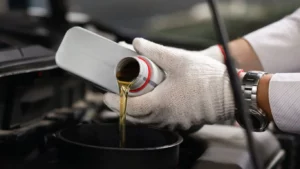Selling your car can seem tough, but with the right steps, it’s easier. You might want a new car, need a smaller one, or just want to sell. This guide will help you sell your car well. We’ll cover everything from getting your car ready to closing the deal.

Key Takeaways
- Properly prepare your vehicle for sale by detailing it and gathering all necessary documents.
- Determine the fair market value of your car to set a competitive price.
- Advertise your car effectively to reach a wide pool of potential buyers.
- Negotiate skillfully with buyers to secure the best deal while maintaining transparency.
- Finalize the sale with proper paperwork and legal requirements to ensure a smooth transfer of ownership.
Prepare Your Vehicle for Sale
Before you list your car for sale, make sure it’s in great condition. Getting it ready right can attract more buyers and lead to a better sale. Here’s what you need to do:
Detailing and Maintenance
First, give your car a deep clean inside and out. Wash the outside, vacuum the inside, and clean all surfaces. A clean car looks good to buyers. Also, do any needed maintenance like oil changes and tire rotations.
Keeping your car in top shape shows you care about it. This can make it seem more valuable to buyers.
Gather Necessary Documents
- Vehicle title: Make sure it’s current and you have it.
- Registration: Give the latest registration.
- Maintenance records: Collect all maintenance and repair records.
- Vehicle history report: Get a report like a CARFAX to show the car’s history.
Having these documents ready makes selling easier. They show you’re open and honest. Buyers will feel more sure about their choice.
By getting your car ready and having the right documents, you’re set for a good used car selling experience. These steps make your car more attractive and help the sale go smoothly.
Determine Your Car’s Value
Finding out how much your car is worth is key when you’re selling it. To get a good price, you need to look at the market, compare sales, and use industry tools. This way, you can set a price that’s fair and attractive to buyers.
Begin by checking the car valuation for your car’s make, model, year, and mileage. Sites like Kelley Blue Book and Edmunds can give you a good starting point. They consider your car’s condition, where it’s located, and recent sales to estimate its value.
Don’t forget to look at the trade-in value too. This value is usually lower than what you can sell it for privately. Knowing this can help you decide if selling it yourself or trading it in is better for you.
| Valuation Source | Private Party Value | Trade-In Value |
|---|---|---|
| Kelley Blue Book | $12,500 | $10,000 |
| Edmunds | $13,000 | $10,500 |
| NADA Guides | $12,800 | $10,200 |
By looking at your car’s value from different trusted sources, you can set a competitive price. This will help you find the right buyers for a successful private party auto sale.
Advertise Your Car Effectively
Once your how to sell a car is ready and in top shape, it’s time to show it off. A smart vehicle sale guide can help you advertise well. This way, you’ll attract the right people interested in your car.
First, list your car on popular online sites. Make your ad catchy and detailed. Include great photos, a full description, and the right keywords. Automobile marketing pros say this makes your ad pop.
Don’t forget about social media. Post about your car on Facebook, Instagram, and Twitter. Ask your friends to share it too. This can get your car seen by more people.
- Highlight your car’s key features and selling points
- Provide clear and accurate information about the vehicle’s condition
- Price your car competitively based on market research
- Respond promptly to inquiries and engage with potential buyers
By using many ways to advertise your how to sell a car, you can show it off more. This increases your chances of selling it fast and for a good price.
| Advertising Channel | Potential Benefits |
|---|---|
| Online Classifieds | Wide reach, ability to showcase detailed information and photos |
| Social Media | Leveraging personal networks, potential for viral sharing |
| Automotive Forums | Targeted audience of car enthusiasts and potential buyers |
| Local Newspapers | Reaching a local audience, building trust through print media |
Good automobile marketing can sell your car fast and for a good price. With a solid vehicle sale guide, you can sell with confidence and get a great deal.
Negotiate with Potential Buyers
When you’re ready to sell your car, negotiating with buyers is key. Knowing the market, competitor prices, and your goals is crucial. It helps you get the best deal for your used car.
Pricing Strategies
Creating a good pricing plan is vital when selling your car privately. First, find out what your car is worth today. Think about its mileage, condition, and extra features. This helps you set a price that’s fair but still competitive.
Be open to talks, but don’t price your car too low. Buyers will try to haggle, so have some wiggle room. This way, you can find a price that both you and the buyer can agree on.
- Research current market prices for similar vehicles
- Consider the condition and features of your car
- Set a competitive, yet realistic, asking price
- Be prepared to negotiate, but don’t sell yourself short
By being confident and knowing your car’s value, you can make a deal that makes both sides happy.

“Negotiation is not a game. It’s a process of discovery, learning and understanding.” – Chester L. Karrass
Finalize the Sale
When you find a buyer for your vehicle, it’s time to wrap up the sale. This step is key and involves making sure all paperwork is done right. Knowing the process well can prevent any issues later on.
Paperwork and Legal Requirements
You’ll need a few important documents to complete the sale. First, check the title to see if you’re listed as the owner. If the title is missing or damaged, get a duplicate from your state’s DMV.
Then, work with the buyer to transfer the title. This means signing the title over and giving them the details like the odometer reading and sale price. Keep a copy of the signed title for yourself.
You might also need to give the buyer a bill of sale or other documents. Check with your local DMV to make sure you have everything needed before you finalize the sale.
| Paperwork Checklist | Requirement |
|---|---|
| Vehicle Title | Signed over to the new owner |
| Bill of Sale | May be required by your state |
| Vehicle Registration | Transferred to the new owner |
| Odometer Disclosure | Accurate mileage reported |
By carefully completing the paperwork for the private party auto sale, you ensure a smooth transaction. Stay organized and informed about your state’s rules to confidently complete the car flipping process.
Consider Trade-In Options
Looking to sell your car easily? Trading it in at a dealership might be the way to go. You might not get the best price, but it’s simple. First, find out what your car is worth and compare it to what you could get selling it yourself.
Understand the trade-in value of your car:
- Use online tools like Kelley Blue Book or Edmunds to estimate your car’s value.
- Think about the market, your car’s make, model, year, mileage, and condition. These affect the offer you get.
Think about the good and bad of trading in your car:
- Convenience: Trading in is quick and easy, saving you time and effort.
- Price: Dealerships offer lower prices because they need to make a profit.
- Negotiation: Dealers are good at negotiating. Be ready to fight for a good deal.
Whether to trade in or sell privately depends on you and your car’s situation. Knowing the trade-in value and considering the pros and cons helps you decide. This way, you can choose the best option for your how to sell a car needs and budget.

“Selling a car can be a daunting task, but trading it in can provide a hassle-free alternative. Just be sure to do your research and negotiate the best possible deal.”
Secure Payment and Transfer Ownership
When you’re ready to sell your vehicle, making sure the payment is secure and the ownership is transferred is key. This process makes the sale smooth and protects both you and the buyer.
Payment Methods
Talk with the buyer about how they want to pay. Cash is easy, but you could also take a certified check or an electronic funds transfer. These options help keep the deal safe from fraud or checks that don’t clear.
Title Transfer
After you get paid, start the title transfer right away. This legal step moves the car’s ownership from you to the buyer. Make sure to follow your state’s rules, which might include paperwork, signatures, and fees.
By focusing on secure payment and title transfer, you’ll make sure the car flipping deal goes well. Both you and the buyer will be happy with the outcome.
“Completing the sale with a smooth title transfer and secure payment is the final step to a successful vehicle sale.”
Post-Sale Checklist
After selling your car, it’s time to check off a few final things. This step makes sure you’ve covered all the bases. You can then feel confident that your car sale is complete.
First, make sure all the paperwork is in order. This includes the title transfer and bill of sale. It’s also important to update your personal records. Don’t forget to remove any personal items from the car before giving it to the new owner.
Next, let your insurance company know about the sale. Cancel any policies or coverage that are no longer needed. This step protects you and saves you money. With these tasks done, you know you’ve sold your car the right way.
FAQ
What steps should I take to prepare my car for sale?
To get your car ready for sale, start by cleaning it inside and out. Make sure all maintenance is up-to-date. Have all important documents like the title and registration ready for buyers.
How can I determine the value of my car?
To find your car’s value, look at the current market and compare sales. Use industry resources to set a fair price. This price should attract buyers while making you a good profit.
What are the best ways to effectively advertise my car for sale?
Advertise your car online and on social media. Make your ad catchy and informative. Talk about your car’s features and condition to draw in buyers.
How should I negotiate with potential buyers?
Know the market and your car’s value when negotiating. Be open to compromise but don’t sell low. Negotiate confidently to get a good deal.
What are the legal requirements and paperwork involved in finalizing the sale?
Make sure all paperwork, like the title transfer, is done right. Follow your state’s rules to avoid problems.
Should I consider trading in my car to a dealership?
Trading in your car is easy but might not get you the best price. Compare the dealership’s offer to selling privately to decide.
How should I handle payment and the title transfer process?
When the sale is complete, get the agreed payment securely. Talk about payment options like cash or electronic transfer. Also, handle the title transfer quickly to transfer ownership.
What should I do after the sale is finalized?
After the sale, check a post-sale list. Make sure all paperwork is correct and update your records. Remove personal items from the car. This helps you close the sale smoothly.






